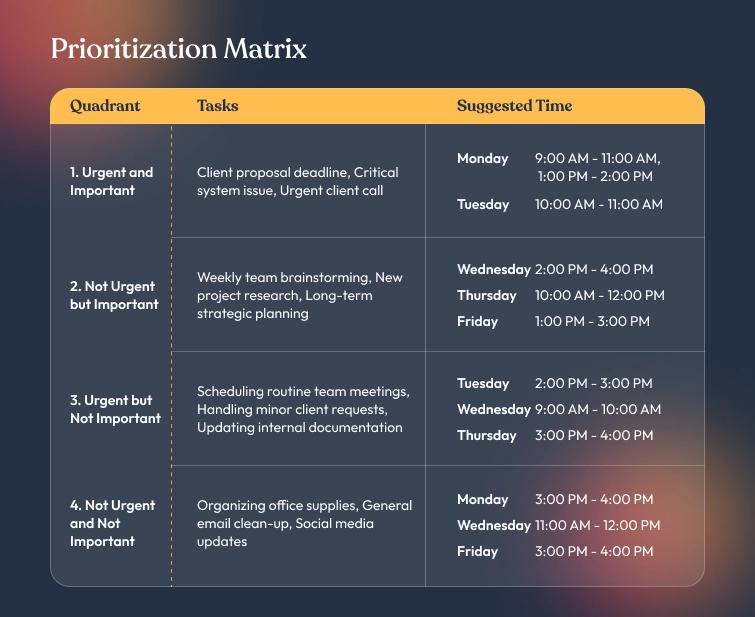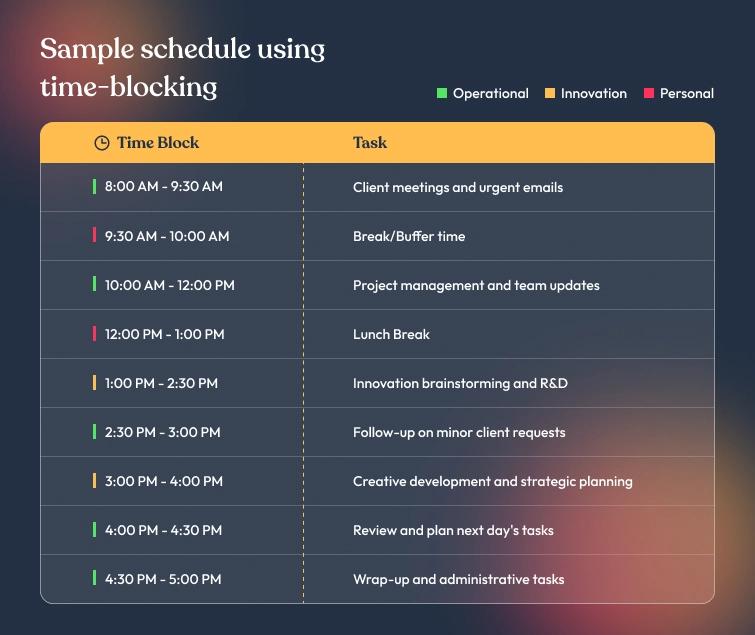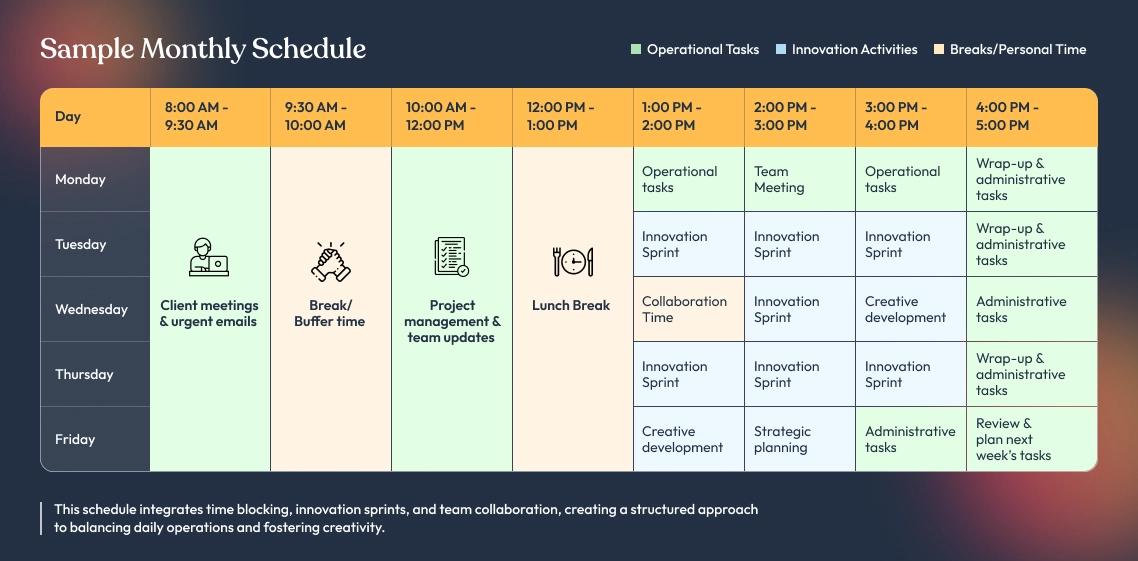4 key strategies for balancing daily operations with innovation in your agency
When we talk with fellow agency owners, one common challenge always comes up: finding time for innovation amidst the hustle of daily operations. Everyone wants to be innovative, but there’s just not enough time in the day. Even when we carve out some time, we often don’t know how to implement it effectively.
We’ve been there too, juggling client meetings, emails, and routine tasks while struggling to find space for new ideas and creative projects. That’s why we’re sharing a schedule that has helped us make time for innovation and let innovation find us. This isn’t our regular schedule—it’s a special routine we implement every six months when things start feeling tedious and the team needs a boost. It’s not realistic to maintain this all the time, but it’s a great way to reset and re-energize our agency.
In this blog, we’ll explore four practical methods to balance daily operations with innovative efforts. These strategies will streamline our routine tasks and dedicate specific time for creative initiatives. Let’s dive in and see how we can strike that perfect balance and elevate our agencies to the next level.
1. Prioritize with a Dual Focus Framework
Balancing daily operations with innovation starts with clear prioritization. By dividing our schedule into two main categories—Daily Operations and Innovation—we can ensure that neither aspect is neglected. Daily Operations include routine tasks that keep the business running smoothly, such as client meetings, emails, and administrative work. Innovation involves creative and strategic activities aimed at driving growth and staying ahead of the competition.
One effective way to categorize and prioritize tasks is by using a prioritization matrix. This tool helps us visualize and organize our tasks based on their urgency and importance. Here’s how we use it:
- Create a Matrix: Divide a sheet of paper or a digital document into four quadrants. Label them as follows:
- Quadrant 1: Urgent and Important (Daily Operations)
- Quadrant 2: Not Urgent but Important (Innovation)
- Quadrant 3: Urgent but Not Important (Daily Operations)
- Quadrant 4: Not Urgent and Not Important (Review and Delegate)
- Categorize Tasks: List all tasks and projects in their respective quadrants. For instance, client meetings and deadline-driven work might fall into Quadrant 1, while brainstorming sessions and long-term strategic planning fit into Quadrant 2.
Allocate Time: Use the matrix to allocate specific times in your schedule for tasks in each quadrant. Ensure that Quadrant 2, where innovation resides, gets dedicated time blocks to foster creativity.

This approach ensures that we’re addressing critical tasks promptly while also making time for important long-term projects and creative thinking.
2. Implement Time Blocking for Flexibility and Focus
Time blocking is a powerful technique where you allocate specific blocks of time to different types of tasks throughout your day. This method helps maintain focus by minimizing interruptions and distractions, ensuring that each task receives dedicated attention. By structuring our day into clearly defined time blocks, we can more effectively manage both daily operations and innovative activities.
To make the most of time blocking, use color-coded blocks to differentiate between various types of tasks. For example, you might use one color for operational tasks and another for innovation activities. This visual separation helps quickly identify what type of work you should be focusing on at any given time.
Here’s a sample schedule using time blocking to illustrate how a typical day might look:

How to Use the Schedule
- Define Your Blocks: Start by defining the types of tasks you need to perform and assign a color code to each category (e.g., operational tasks in blue, innovation in green).
- Allocate Time: Assign specific time blocks in your daily schedule for each type of task, ensuring that you’re dedicating sufficient time to both operational and innovation activities.
- Stick to the Plan: Follow the schedule as closely as possible. If unexpected tasks arise, try to adjust your blocks without disrupting your focus on high-priority activities.
- Review and Adjust: Regularly review how well your time blocking is working. Adjust the time blocks as needed based on your workload and effectiveness.
By using time blocking with clear visual cues, we can enhance our productivity, stay focused on our priorities, and maintain a balanced approach to both daily operations and innovative endeavors.
3. Schedule Regular Innovation Sprints
Innovation sprints are dedicated periods where the focus shifts entirely to creative and forward-thinking tasks. These sprints provide uninterrupted time for brainstorming, developing new ideas, and exploring new opportunities. By setting aside specific times for innovation, we can ensure that creative efforts aren’t overshadowed by daily operational demands.
To maximize the benefits of innovation sprints, allocate specific days or times each week exclusively for these activities. This helps create a routine where team members know they have dedicated time to focus on innovative projects without the interference of routine tasks.
Here’s how we set up a sprint schedule and the benefits of having dedicated time for innovation:
- Identify Sprint Times: Determine the best days and times for innovation sprints. Consider team availability and energy levels to select optimal periods.
- Block Out Time: Allocate these periods in your calendar and ensure they are protected from other meetings and tasks.
- Communicate Clearly: Inform your team about the sprint schedule so they can plan their work around these dedicated times.
Sample Schedule:
- Innovation Sprint Days: Every Tuesday and Thursday from 2:00 PM – 4:00 PM
- Operational Tasks: Focus on routine operations and client work on other days of the week.
Benefits of Innovation Sprints
- Focused Creativity: Having dedicated time for innovation allows team members to dive deep into creative tasks without the constant interruption of daily operational duties.
- Improved Productivity: Regular sprints help ensure that innovation is consistently integrated into the workflow, leading to more frequent and impactful creative output.
- Balanced Workload: By segregating innovation time from routine tasks, we prevent burnout and maintain a balanced approach to managing both daily operations and long-term growth initiatives.
Implementing regular innovation sprints provides a structure for creativity and ensures that innovative thinking remains a key part of our agency’s operations. This approach helps us stay ahead of the curve while effectively managing our daily responsibilities.
4. Leverage Team Collaboration and Delegation
Delegating tasks and fostering team collaboration are crucial for freeing up time and resources, allowing us to focus on innovation. By effectively distributing responsibilities and encouraging team interaction, we can ensure that routine tasks are handled efficiently, leaving more room for creative and strategic work.
Use project management tools and schedule regular check-ins to streamline delegation and collaboration. Tools like Asana, Trello, or Monday.com help track task progress, manage deadlines, and communicate effectively. Regular team meetings and updates keep everyone aligned and focused on shared goals.
Example
Here’s how we implement strategies for effective delegation and collaboration within our team:
- Assign Responsibilities Clearly: Use project management tools to assign tasks to team members based on their skills and expertise. Ensure everyone understands their role and deadlines.
- Set Up Regular Check-Ins: Schedule regular meetings to review progress, address any issues, and make necessary adjustments. This keeps the team on track and ensures that tasks are completed efficiently.
- Encourage Open Communication: Foster a collaborative environment where team members feel comfortable sharing ideas and providing feedback. This can lead to more innovative solutions and improvements.
To effectively manage both, we’ve created a monthly schedule that incorporates time blocking, regular innovation sprints, and team collaboration. Before setting up this schedule, it’s crucial to use a prioritization matrix to categorize tasks. With clear priorities, the schedule helps allocate focused time for routine tasks and creative projects. This approach ensures operational efficiency while fostering growth and innovation.

This schedule integrates time blocking, innovation sprints, and team collaboration, creating a structured approach to balancing daily operations and fostering creativity.
Conclusion
Balancing daily operations with innovation requires a strategic approach. By implementing a dual-focus framework, using time blocking, scheduling regular innovation sprints, and leveraging team collaboration and delegation, we can effectively manage our time and resources. These methods help us stay organized, foster creativity, and maintain productivity.
We encourage you to try out these strategies and adapt them to fit your unique needs. By doing so, you’ll be better equipped to handle the demands of daily operations while also driving innovation and growth in your agency.
And if you’re looking for additional support, consider leveraging a team of experienced professionals like the ones at TogetherWeship. Our expertise can help streamline your processes, free up valuable time, and ensure that both your daily operations and innovative projects are handled efficiently. Let’s elevate your agency together!